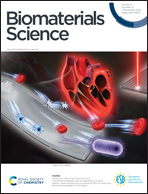Growth factor-mimicking 3,4-dihydroxyphenylalanine-encoded bioartificial extracellular matrix like protein promotes wound closure and angiogenesis†
Abstract
The present work reports a new route to prepare a “smart biomaterial” by mimicking long-acting cellular growth factor showing enhanced cell–material interactions by promoting cell proliferation and angiogenesis. For that, reactive non-proteogenic amino acid 3,4-dihydroxyphenylalanine (DOPA) was genetically introduced into an intrinsic triple-helical hierarchical structure forming protein to initiate hierarchical self-assembly to form a macromolecular structure. The self-assembled scaffold displayed vascular endothelial growth factor mimicking the pro-angiogenic reactive group for repairing and remodeling of damaged tissue cells. We customized the recombinant collagen-like protein (CLP) with DOPA to promote rapid wound healing and cell migrations. Selective incorporation of catechol in variable and C-terminal region of CLP enhanced interaction between inter- and intra-triple-helical collagen molecules that resulted in a structure resembling higher-order native collagen fibril. Turbidity analysis indicated that the triple-helical CLP self-assembled at neutral pH via a catechol intra-crosslinking mechanism. After self-assembly, only DOPA-encoded CLP formed branched filamentous structures suggesting that catechol mediated network coordination. The catechol-encoded CLP also acted as a “smart material” by mimicking long-acting cellular growth factor showing enhanced cell–material interactions by promoting cell proliferation and angiogenesis. It eliminates release rate, stability, and shelf-life of hybrid growth factor conjugated biomaterials. The newly synthesized CLP has the potential to promote accelerated cell migration, pro-angiogenesis, and biocompatibility and could be used in the field of implantable medical devices and tissue engineering.



 Please wait while we load your content...
Please wait while we load your content...